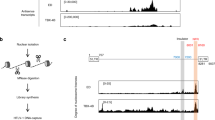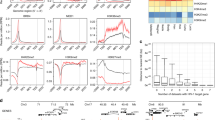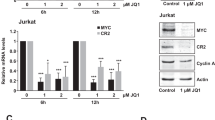Abstract
Human T-cell leukaemia viruses (HTLVs) have genomic organization distinct from that of other replication-competent retroviruses, possessing four genes, gag, pol, env and χ. The unique fourth gene, χ (also referred to as lor), is located between env and the 3′ long terminal repeat (LTR), encoding a protein of relative molecular mass 40,000 for HTLV-I and 37,000 for HTLV-II1,2, located in the nucleus of infected cells3,4. HTLV-I is the causative agent of adult T-cell leukaemia (ATL), a T-lymphocyte malignancy5,6, while HTLV-II has been found associated with a T-cell variant of hairy cell leukaemia7,8. Both viruses immortalize T cells in vitro9–11. However, the mechanism of cellular transformation induced by HTLV is not known as there seems to be no common site of provirus integration in primary ATL cells12 and the viras contains no classical oncogene sequences13,14. These observations have provoked speculation that the unique and strongly conserved χ protein (85% amino-acid homology between HTLV-I and -II) is involved in HTLV leukaemogenesis. Recent mutagenesis experiments in our laboratory have shown that the χ gene is essential for HTLV replication15. It has also been shown that the LTRs of HTLV and the related bovine leukaemia virus (BLV) are activated in trans in virus-infected cells16–19, and, although such experiments did not directly demonstrate a role for the χ protein in transcriptional activation, it has been suggested that the χ protein is responsible for the transcriptional activation of the LTR and may be involved in cellular transformation3,4,16. We have now developed a transient co-transfection assay which demonstrates that transcriptional activation of the HTLV LTR is mediated solely by the χ protein and that no other virus genes are required.
This is a preview of subscription content, access via your institution
Access options
Subscribe to this journal
Receive 51 print issues and online access
$199.00 per year
only $3.90 per issue
Buy this article
- Purchase on Springer Link
- Instant access to full article PDF
Prices may be subject to local taxes which are calculated during checkout
Similar content being viewed by others
References
Slamon, D. J., Shimotohno, K., Cline, M. J., Golde, D. W. & Chen, I. S. Y. Science 226, 61–65 (1984).
Lee, T. H. et al. Science 226, 57–61 (1984).
Goh, W. C., Sodroski, J., Rosen, C., Essex, M. & Haseltine, W. A. Science 227, 1227–1228 (1984).
Slamon, D. J. et al. Science 228, 1427–1430 (1985).
Gallo, R. C. et al. Cancer Res. 43, 3892–3899 (1983).
Hinuma, Y. et al. Proc. natn, Acad. Sci. U.S.A. 78, 6476–6480 (1981).
Kalyanaraman, V. S. et al. Science 218, 571–573 (1982).
Saxon, A., Stevens, R. H. & Golde, D. W. Ann. intern. Med. 88, 323–326 (1978).
Miyoshi, I. et al. Nature 294, 770–771 (1981).
Chen, I. S. Y., Quan, S. G. & Golde, D. W. Proc. natn. Acad. Sci. U.S.A. 80, 7006–7009 (1983).
Popovic, M., Lange-Wantzin, G., Savin, P. S., Mann, D. & Gallo, R. C. Proc. natn. Acad. Sci. U.S.A. 80, 5402–5406 (1983).
Seiki, M., Eddy, R., Strows, T. B. & Yoshida, M. Nature 309, 640–642 (1984).
Seiki, M., Hattori, S., Hirayma, Y. & Yoshida, M. Proc. natn. Acad. Sci. U.S.A. 80, 3618–3622 (1983).
Shimotohno, K. et al. Proc. natn. Acad. Sci. U.S.A. 82, 3101–3105 (1985).
Chen, I. S. Y. et al. Science 229, 54–58 (1985).
Sodroski, J. G., Rosen, C. A. & Haseltine, W. A. Science 225, 381–385 (1984).
Rosen, C. A., Kettman, R., Burny, A. & Haseltine, W. A. Science 227, 320–322 (1984).
Derse, D., Caradonna, S. J. & Casey, J. W. Science 227, 317–320 (1985).
Fujisawa, J., Seiki, M., Koyokawa, T. & Yoshida, M. Proc. natn. Acad. Sci. U.S.A. 82, 2277–2281 (1985).
Chen, I. S. Y., McLaughlin, J., Gasson, J. C., Clark, S. C. & Golde, D. W. Nature 305, 502–505 (1983).
Wachsman, W. et al. Science 228, 1534–1537 (1985).
Chen, I. S. Y., McLaughlin, J. & Golde, D. W. Nature 309, 276–279 (1984).
Broome, S. & Gilbert, W. Cell 40, 537–546 (1985).
Varmus, H. E., Padgett, T., Heasley, S., Simon, G. & Bishop, J. M. Cell 11, 307–319 (1977).
Chen, I. S. Y. & Temin, H. M. J. Virol. 41, 183–191 (1982).
Jones, N. & Shenk, T. Proc. natn. Acad. Sci. U.S.A. 76, 3665–3669 (1979).
Berk, A. J., Lee, F., Harrison, T., Williams, J. & Sharp, P. A. Cell 17, 935–944 (1979).
Ruley, H. E. Nature 304, 602–606 (1983).
Montell, C., Courtois, G., Eng, C. & Berk, A. Cell 36, 951–961 (1984).
Ralston, R. & Bishop, J. M. Nature 306, 803–806 (1983).
Chen, I. S. Y., Cann, A. J., Shah, N. P. & Gaynor, R. B. Science 230, 570–573 (1985).
Land, H., Parada, L. F. & Weinberg, R. A. Science 222, 771–778 (1983).
Kingston, R. E., Baldwin, S. & Sharp, P. A. Cell 41, 3 (1985).
Southern, E. M. & Berg, P. J. molec. appl. Genet. 1, 327–341 (1982).
Mellon, P., Parker, V., Gluzman, Y. & Maniatis, T. Cell 27, 279–288 (1981).
Gorman, C. M., Moffat, L. F. & Howard, B. H. Molec. Cell Biol. 2, 1044–1051 (1982).
Chatis, P. A., Holland, C. A., Hartley, J. W., Rowe, W. P. & Hopkins, N. Proc. natn. Acad. Sci. U.S.A. 80, 4408–4411 (1983).
Wachsman, W., Shimotohno, K., Clark, S. C., Golde, D. W. & Chen, I. S. Y. Science 226, 177–179 (1984).
Felber, B. K., Paskelos, H., Kleinman-Ewing, C., Wong-Staal, F. & Pavlakis, G. N. Science 229, 675–679 (1985).
Sodroski, J., Rosen, C., Goh, W. C. & Haseltine, W. Science 228, 1430–1434 (1985).
Author information
Authors and Affiliations
Rights and permissions
About this article
Cite this article
Cann, A., Rosenblatt, J., Wachsman, W. et al. Identification of the gene responsible for human T-cell leukaemia virus transcriptional regulation. Nature 318, 571–574 (1985). https://doi.org/10.1038/318571a0
Received:
Accepted:
Published:
Issue Date:
DOI: https://doi.org/10.1038/318571a0
This article is cited by
-
Molecular mechanisms involved in HIV-1 Tat-mediated induction of IL-6 and IL-8 in astrocytes
Journal of Neuroinflammation (2014)
-
Oncogenes and RNA splicing of human tumor viruses
Emerging Microbes & Infections (2014)
-
Phosphorylation regulates human T-cell leukemia virus type 1 Rex function
Retrovirology (2009)
-
Involvement of TORC2, a CREB co-activator, in the in vivo-specific transcriptional control of HTLV-1
Retrovirology (2009)
-
Human T-cell leukemia virus type 2 post-transcriptional control protein p28 is required for viral infectivity and persistence in vivo
Retrovirology (2008)
Comments
By submitting a comment you agree to abide by our Terms and Community Guidelines. If you find something abusive or that does not comply with our terms or guidelines please flag it as inappropriate.



